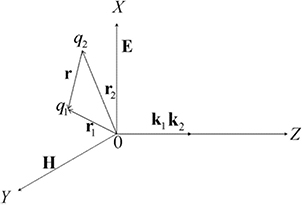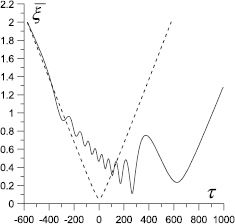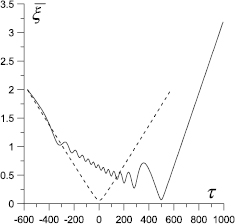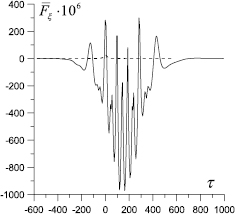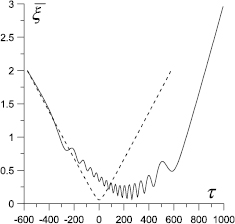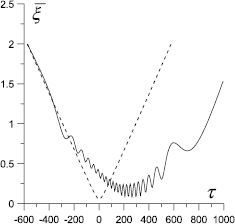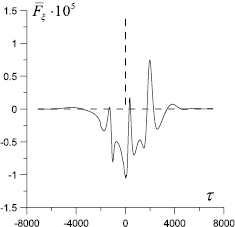Abstract
We consider the effective interaction force of identically charged nonrelativistic particles (electrons and heavy nuclei) in a strong pulsed field of two co-propagating laser waves. It is shown that under certain conditions, the effective interaction force can become a force of attraction. Moreover, it is possible to significantly increase the duration of the effective force of attraction via the time shift of the pulse peak of the second wave relatively to the first one. The appearance of the effective force of attraction may be experimentally verified in the framework of modern research projects, which use sources of pulsed laser radiation (FAIR, XFEL, ELI).
Export citation and abstract BibTeX RIS
1. Introduction
There are many works devoted to the study of the interaction of similarly charged particles in the presence of an electromagnetic field (see, the works [1–14]). Thus, resonant and nonresonant interaction of electrons (positrons) in the field of a plane electromagnetic wave has been considered in reviews [1–4]. Experimental verification of quantum electrodynamics effects in laser fields was carried out at the accelerator complex SLAC [15, 16] and is also included in to the scientific program of the international project FAIR based on the laser system PHELIX [17]. The possibility of electron attraction in the presence of a plane electromagnetic wave was first shown by Oleinik [5, 6]. However, the theoretical proof of the attraction possibility was given by Kazantsev and Sokolov for the interaction of a classical relativistic electron in the field of a plane wave [7]. We also note [8]. It is very important to point out, that the classical electrons attraction in the field of a plane monochromatic electromagnetic wave is only possible for particles with relativistic energies. In the authors works (see, review [4], articles [9, 14]) the possibility of the attraction of nonrelativistic electrons (identically charged ions) in the pulsed laser field was shown. Thus, the interaction of electrons (light ions) in the pulsed field of a single laser wave was studied in [9, 10]. The nonrelativistic electrons interaction in the pulsed field of two counter-propagating laser waves moving perpendicularly to the initial direction of electrons motion was considered in [11]. The interaction of nonrelativistic light ions moving almost parallel to each other in the propagation direction of the pulsed field of two counter-propagating laser waves moving in a parallel direction to ions was studied in [12]. Interaction of two nonrelativistic heavy nuclei (uranium 235), moving towards each other perpendicular to the propagation direction of two counter-propagating laser waves was also studied [13]. The possibility of a considerable delay of the uranium nuclei after their closest approachment was shown. The effective interaction force of two hydrogen atoms (after their ionization) in the pulsed field of the two counter-propagating laser waves was considered in [14].
In contrast to the works, mentioned above, the influence of pulsed field of two co-propagating laser waves on the effective interaction force of two electrons and two identically charged heavy nuclei is studied in this article. Thus, the main attention is focused on the influence of the time shift of the pulse peak of one wave relatively to the second on the effective interaction force of particles.
2. Interaction of identically charged particles in the pulsed field of two co-propagating laser waves
We study the interaction of two nonrelativistic identically charged particles moving towards each other in the  plain in the pulsed field of two laser waves, propagating along the
plain in the pulsed field of two laser waves, propagating along the  axis in the one direction (see, figure 1).
axis in the one direction (see, figure 1).
Figure 1. Interaction kinematics of two classical identically charged particles in the pulsed field of two co-propagating laser waves.
Download figure:
Standard image High-resolution imageWe assume the strength of the electric and magnetic field is in the following form:






Here,  and
and  (
( ) are the strength of an electric and magnetic field in the peak of a pulse, respectively;
) are the strength of an electric and magnetic field in the peak of a pulse, respectively;  and
and  are the unit vectors directed along the
are the unit vectors directed along the  and
and  axes;
axes;  and
and  are the pulse duration and frequency of the first and second wave, respectively.
are the pulse duration and frequency of the first and second wave, respectively.
It is a well-known fact that in the frame of the dipole approximations on particle interaction with the plane-wave field the last does not affect the particle relative motion in the center-of-mass system. Thereby, we consider particle motion in the laser field beyond the dipole approximation (to an accuracy of quantities of the order  ,
,  is the relative velocity). Newton equations, for the motion of two identically charged particles with the mass
is the relative velocity). Newton equations, for the motion of two identically charged particles with the mass  and charge
and charge  (
( results from figure 1) in the pulsed field of two co-propagating laser waves (1)–(6), are determined by the following expressions:
results from figure 1) in the pulsed field of two co-propagating laser waves (1)–(6), are determined by the following expressions:


Here,  and
and  are the particle radius-vectors.
are the particle radius-vectors.
Subsequent consideration we carry out in the center-of-mass system:

Equations (7) and (8) assume the form:


In the center-of-mass system, equations for a particle relative motion do not depend on equations for the motion of the center of the mass, because one must allow for the accuracy of quantities of the order  , and the accuracy of quantities of the order
, and the accuracy of quantities of the order  shall be ignored (
shall be ignored ( is the relative velocity):
is the relative velocity):

We may write equation (12) in the following dimensionless form:







Here,  is the radius-vector of the relative distance between particles in the units of the wavelength; the parameter
is the radius-vector of the relative distance between particles in the units of the wavelength; the parameter  is numerically equal to the ratio of the oscillation velocity of a particle in the peak of a pulse
is numerically equal to the ratio of the oscillation velocity of a particle in the peak of a pulse  to the velocity of light
to the velocity of light  (hereinafter, we consider the parameter
(hereinafter, we consider the parameter  as the oscillation velocity); the parameter
as the oscillation velocity); the parameter  is numerically equal to the ratio of the energy of the Coulomb interaction of particle with a reduced mass
is numerically equal to the ratio of the energy of the Coulomb interaction of particle with a reduced mass  at the wavelength to the particle rest energy;
at the wavelength to the particle rest energy;  —is the time shift of a pulse peak of the second wave. With (13)–(19) in consideration the equation (12) is determined as:
—is the time shift of a pulse peak of the second wave. With (13)–(19) in consideration the equation (12) is determined as:

The right-hand parts of the equations in the system (20) determine the projections of the effective force  , acting on particles in the center-of-mass system, onto the direction
, acting on particles in the center-of-mass system, onto the direction  of particle relative motion is obtained as:
of particle relative motion is obtained as:

We emphasize that the summand in the braces, which is determined by the pulsed field, has the order  (
( ) of the magnitude and in the dipole approximation (
) of the magnitude and in the dipole approximation ( ) vanishes.
) vanishes.
The pulse duration considerably exceeds the period of wave rapid oscillation ( ) for a majority of modern pulsed lasers, that is:
) for a majority of modern pulsed lasers, that is:

Consequently, the projection of the effective force (21) and relative distance between particles have to be averaged over the period of wave rapid oscillation:

We consider the quantity  as the averaged effective force of particle interaction. One can see that the condition
as the averaged effective force of particle interaction. One can see that the condition  determines particle repulsion and the condition
determines particle repulsion and the condition  determines particle attraction. We note that expressions (20)–(23) strictly consider the interaction with the Coulomb field and the pulsed-wave field, and have no the analytical solution. In subsequent analysis we will study these equations numerically.
determines particle attraction. We note that expressions (20)–(23) strictly consider the interaction with the Coulomb field and the pulsed-wave field, and have no the analytical solution. In subsequent analysis we will study these equations numerically.
3. Interaction of two electrons
We consider the case, if two classical nonrelativistic electrons move towards each other in the  plain and are perpendicular to the two pulsed laser waves, propagating along the
plain and are perpendicular to the two pulsed laser waves, propagating along the  axis (see, figure 1, where
axis (see, figure 1, where  ).
).
The electron initial relative coordinates and velocities are the following:

The effective time of electron interaction: ![$\tau \in \left[1200\div 1600\right]$](https://content.cld.iop.org/journals/1555-6611/25/7/076001/revision1/lp513621ieqn042.gif) , (
, (![$t\in \left[4\div 6\right]\cdot {{10}^{-13}}\text{s}$](https://content.cld.iop.org/journals/1555-6611/25/7/076001/revision1/lp513621ieqn043.gif) ). The wave frequencies are
). The wave frequencies are  , pulse durations are
, pulse durations are  (
( ). The peaks of the first and second pulsed waves occur at the points
). The peaks of the first and second pulsed waves occur at the points  and the time shift of the pulse peak of the second wave
and the time shift of the pulse peak of the second wave  is taken as the initial conditions. The field intensities (oscillation velocity
is taken as the initial conditions. The field intensities (oscillation velocity  ) are varied. Numerical solving of the systems of equations for relative motion (20) and projections of the effective force of electron interaction (
) are varied. Numerical solving of the systems of equations for relative motion (20) and projections of the effective force of electron interaction ( ) onto the relative direction (21) with (19), results in the following consequences.
) onto the relative direction (21) with (19), results in the following consequences.
It was found that the external pulsed field of two counter-propagating laser waves has a considerable effect on the relative motion of electrons, when the oscillation velocity considerably exceeds the relative velocity of translational motion ( , see, [4, 11]). The external pulsed field of two laser waves propagating in one direction with identical parameters, also has a considerable effect on the relative motion of the particles (see, figure 2 and equation (24)).
, see, [4, 11]). The external pulsed field of two laser waves propagating in one direction with identical parameters, also has a considerable effect on the relative motion of the particles (see, figure 2 and equation (24)).
Figure 2. Dependence of the averaged relative distance  (in the units
(in the units  ) on the interaction time
) on the interaction time  (the solid line). The dashed line corresponds to the case where the external field is absent. The oscillation velocity:
(the solid line). The dashed line corresponds to the case where the external field is absent. The oscillation velocity:  (the field intensity:
(the field intensity:  ). The time shift of a pulse peak of the second wave
). The time shift of a pulse peak of the second wave  .
.
Download figure:
Standard image High-resolution imageWe conclude that the influence of the pulsed field of two co-propagating laser waves on the relative distance appears before electrons closest approach, as opposed to the counter-propagating waves' case. It is caused by the chosen initial conditions of electrons kinematics (see, equation (24) and initial conditions in [4]). Electrons move towards each other in the  plain, as opposed to the case when electrons move towards each other along the
plain, as opposed to the case when electrons move towards each other along the  axis. Figures 2–3 show that until even the moment when the pulse reaches its peak (
axis. Figures 2–3 show that until even the moment when the pulse reaches its peak ( marks the peak of a pulse of both waves) the pulsed field of two waves influences the relative distance considerably. Thus, at the distance
marks the peak of a pulse of both waves) the pulsed field of two waves influences the relative distance considerably. Thus, at the distance  (in the units
(in the units  ) electrons are confined by the field during the time equal to the pulse duration (see, figure 3). Consequently, the electrons are confined by the field on distance
) electrons are confined by the field during the time equal to the pulse duration (see, figure 3). Consequently, the electrons are confined by the field on distance  during the time equal to the three pulse duration (see, left and righthand parts of figure 3).
during the time equal to the three pulse duration (see, left and righthand parts of figure 3).
Figure 3. Dependence of the averaged relative distance  (in the units
(in the units  ) on the interaction time
) on the interaction time  (the solid line). The dashed line corresponds to the case where the external field is absent. The oscillation velocity:
(the solid line). The dashed line corresponds to the case where the external field is absent. The oscillation velocity:  ,
,  (the field intensity:
(the field intensity:  ,
,  ). The time shift of a pulse peak of the second wave
). The time shift of a pulse peak of the second wave  .
.
Download figure:
Standard image High-resolution imageNote that in all works with nonrelativistic particles in a pulsed field of two laser waves, the pulse peaks coincide at the one point  [4, 11–13]. Let us shift the pulse peak of the second wave on some time slot
[4, 11–13]. Let us shift the pulse peak of the second wave on some time slot  (see, figure 4, equation (16)).
(see, figure 4, equation (16)).
Figure 4. Dependence of the averaged relative distance  (in the units
(in the units  ) on the interaction time
) on the interaction time  (the solid line). The dashed line corresponds to the case if the external field is absent. The oscillation velocity:
(the solid line). The dashed line corresponds to the case if the external field is absent. The oscillation velocity:  ,
,  (the field intensity:
(the field intensity:  ,
,  ). The time shift of a pulse peak of the second wave
). The time shift of a pulse peak of the second wave  .
.
Download figure:
Standard image High-resolution imageFigure 4 shows, that the electrons interaction before and after their closest approach is smooth and almost symmetrical in contrast to the case with no shift of the pulse peak of the second wave. The time shift of a pulse peak of the second wave results in electron confinement at a certain averaged distance  during the time
during the time  (
( ) with the amplitude of oscillating
) with the amplitude of oscillating  . One can see that confinement of electrons occurs at the distance of about a wavelength during a long time
. One can see that confinement of electrons occurs at the distance of about a wavelength during a long time  (
( ). It is a considerably longer time in comparison to the case of counter-propagating waves, exceeding more than twice. It confirms the stable region of negative values of the effective force of electrons interaction on figure 5.
). It is a considerably longer time in comparison to the case of counter-propagating waves, exceeding more than twice. It confirms the stable region of negative values of the effective force of electrons interaction on figure 5.
Figure 5. Dependence of the averaged effective force  (in the units
(in the units  ) on the interaction time
) on the interaction time  (the solid line). The dashed line corresponds to the case if the external field is absent. The oscillation velocity:
(the solid line). The dashed line corresponds to the case if the external field is absent. The oscillation velocity:  ,
,  (the field intensity:
(the field intensity:  ,
,  ). The time shift of a pulse peak of the second wave
). The time shift of a pulse peak of the second wave  .
.
Download figure:
Standard image High-resolution imageOne can see, that the region of the attraction force corresponds to the time interval ![$\tau \in \left[-150:450\right]$](https://content.cld.iop.org/journals/1555-6611/25/7/076001/revision1/lp513621ieqn096.gif) . This is more than twice the length of the duration of the pulse peak (
. This is more than twice the length of the duration of the pulse peak ( ). Stable confinement occurs for the intensity interval
). Stable confinement occurs for the intensity interval  (see, figures 6 and 7).
(see, figures 6 and 7).
Figure 6. Dependence of the averaged relative distance  (in the units
(in the units  ) on the interaction time
) on the interaction time  (the solid line). The dashed line corresponds to the case if the external field is absent. The oscillation velocity:
(the solid line). The dashed line corresponds to the case if the external field is absent. The oscillation velocity:  ,
,  (the field intensity:
(the field intensity:  ,
,  ). The time shift of a pulse peak of the second wave
). The time shift of a pulse peak of the second wave  .
.
Download figure:
Standard image High-resolution imageFigure 7. Dependence of the averaged relative distance  (in the units
(in the units  ) on the interaction time
) on the interaction time  (the solid line). The dashed line corresponds to the case that the external field is absent. The oscillation velocity:
(the solid line). The dashed line corresponds to the case that the external field is absent. The oscillation velocity:  ,
,  (the field intensity:
(the field intensity:  ,
,  ). The time shift of a pulse peak of the second wave
). The time shift of a pulse peak of the second wave  .
.
Download figure:
Standard image High-resolution imageCalculations have shown that the time shift of a pulse peak must not exceed the pulse duration of the first or second wave. For the case of electrons, the optimum value of the time shift of a pulse peak of the second wave was  . This is correct for the given initial conditions (24) and parameters of waves.
. This is correct for the given initial conditions (24) and parameters of waves.
Consequently, electron attraction in the pulsed field of two co-propagating laser waves occurs in the case where the particle oscillation velocity considerably exceeds their relative velocity. This attraction can be strengthened for the case of identical frequency and pulse duration, but a different intensity and time shift of a pulse peak of the second wave. Therefore, it is possible to increase the time of electron confinement at a certain averaged effective distance in comparison with the case of one and two counter-propagating pulsed laser waves by 1, 5 times.
4. Interaction of two heavy nuclei
We consider interaction of two classical nonrelativistic heavy nuclei with charges  and
and  , moving in the initial time in the
, moving in the initial time in the  plain and perpendicular to the two pulsed laser waves, propagating along the
plain and perpendicular to the two pulsed laser waves, propagating along the  axis (see, figure 1). The equations (20) and (21) were solved numerically for completely ionized uranium nuclei with the charge number
axis (see, figure 1). The equations (20) and (21) were solved numerically for completely ionized uranium nuclei with the charge number  and mass number
and mass number  . We consider the following initial relative coordinates and velocities of nuclei:
. We consider the following initial relative coordinates and velocities of nuclei:

The effective time of nuclei interaction:  , (
, ( ). The wave frequencies are
). The wave frequencies are  , pulse durations are
, pulse durations are  (
( ). Peaks of the first and second pulse waves are at the point
). Peaks of the first and second pulse waves are at the point  and the time shift of the pulse peak of the second wave
and the time shift of the pulse peak of the second wave  is taken as the initial condition. The field intensities (oscillation velocity
is taken as the initial condition. The field intensities (oscillation velocity  ) are varied. Numerical calculations led to the following consequences.
) are varied. Numerical calculations led to the following consequences.
The external field does not impede nuclei approach at the distance, comparable with the 'Coulomb' one ( ), i.e. such a distance at which particles can approach with the external field absence (see, figure 8). The particles approach at the distances of the order of the wavelength. Coulomb repulsion increases the distance between the nuclei up to four wavelengths. However, at this point the maximum peak of the laser pulse is obtained. The attraction of the magnetic currents generated by the strength of a magnetic field of waves occurs. The attraction of the uranium nuclei is observed again.
), i.e. such a distance at which particles can approach with the external field absence (see, figure 8). The particles approach at the distances of the order of the wavelength. Coulomb repulsion increases the distance between the nuclei up to four wavelengths. However, at this point the maximum peak of the laser pulse is obtained. The attraction of the magnetic currents generated by the strength of a magnetic field of waves occurs. The attraction of the uranium nuclei is observed again.
Figure 8. Dependence of the averaged relative distance  (in the units
(in the units  ) on the interaction time
) on the interaction time  (the solid line). The dashed line corresponds to the case if the external field is absent. The oscillation velocity:
(the solid line). The dashed line corresponds to the case if the external field is absent. The oscillation velocity:  (the field intensity:
(the field intensity:  ). The time shift of a pulse peak of the second wave
). The time shift of a pulse peak of the second wave  .
.
Download figure:
Standard image High-resolution imageVarying intensities of the waves leads to the close approach (see, figure 9). Thus, the nucleus approach at the distance  after the pulse peak of the laser wave is observed. The duration of the attraction force (
after the pulse peak of the laser wave is observed. The duration of the attraction force ( ) exceeds the pulse duration (
) exceeds the pulse duration ( ) of the both waves (see, figure 10).
) of the both waves (see, figure 10).
Figure 9. Dependence of the averaged relative distance  (in the units
(in the units  ) on the interaction time
) on the interaction time  (the solid line). The dashed line corresponds to the case if the external field is absent. The oscillation velocity:
(the solid line). The dashed line corresponds to the case if the external field is absent. The oscillation velocity:  ,
,  (the field intensity:
(the field intensity:  ,
,  ). The time shift of a pulse peak of the second wave
). The time shift of a pulse peak of the second wave  .
.
Download figure:
Standard image High-resolution imageFigure 10. Dependence of the averaged effective force  (in the units
(in the units  ) on the interaction time
) on the interaction time  (the solid line). The dashed line corresponds to the case if the external field is absent. The oscillation velocity:
(the solid line). The dashed line corresponds to the case if the external field is absent. The oscillation velocity:  ,
,  (the field intensity:
(the field intensity:  ,
,  ). The time shift of a pulse peak of the second wave
). The time shift of a pulse peak of the second wave  .
.
Download figure:
Standard image High-resolution imageLet's shift the pulse peak of the second wave on to some time slot  (see, figure 11, equation (16)). Calculations have shown that the time shift of a pulse peak must not exceed the pulse duration of the first or second wave (
(see, figure 11, equation (16)). Calculations have shown that the time shift of a pulse peak must not exceed the pulse duration of the first or second wave ( ). For our case, the optimum value of the time shift of a pulse peak of the second wave was
). For our case, the optimum value of the time shift of a pulse peak of the second wave was  (see, figure 11).
(see, figure 11).
Figure 11. Dependence of the averaged relative distance  (in the units
(in the units  ) on the interaction time
) on the interaction time  (the solid line). The dashed line corresponds to the case if the external field is absent. The oscillation velocity:
(the solid line). The dashed line corresponds to the case if the external field is absent. The oscillation velocity:  ,
,  (the field intensity:
(the field intensity:  ,
,  ). The time shift of a pulse peak of the second wave
). The time shift of a pulse peak of the second wave  .
.
Download figure:
Standard image High-resolution imageOne can see, the result is similar to the case of identical intensities (compare figures 8 and 11). But, the particles slowdown is shown after a pulse peak of the waves (right part of figure 11). The duration of the particles slowdown corresponds to 2/3 of the pulse duration of the second wave  .
.
Figure 12 shows the region of attraction force after the pulse peak. Thus, the effective force of interaction becomes an attractive force and uranium nuclei move considerably slower away from each other.
Figure 12. Dependence of the averaged effective force  (in the units
(in the units  ) on the interaction time
) on the interaction time  (the solid line). The dashed line corresponds to the case if the external field is absent. The oscillation velocity:
(the solid line). The dashed line corresponds to the case if the external field is absent. The oscillation velocity:  ,
,  (the field intensity:
(the field intensity:  ,
,  ). The time shift of a pulse peak of the second wave
). The time shift of a pulse peak of the second wave  .
.
Download figure:
Standard image High-resolution imageConsequently, the effect of a considerable delay of the nonrelativistic uranium nuclei occurs if their initial velocity and oscillation velocity are of the same order of the magnitude. Herewith the time of delay may exceed the time for nuclei fly apart in the external field absence by an half of the magnitude. The time shift of a pulse peak of the second wave does not have a considerable impact on the earlier obtained result [13].
Thus, the experimental study of identically charged particles interaction may be verified in the fields produced by picosecond pulsed lasers which generate radiation within the optical frequency range.
Such scientific facilities are employed in the SLAC (Princeton Rochester, SLAC, Tennessee collaboration) and Brookhaven National Laboratory (USA) research centers, and also in the frame of the FAIR Project (Darmstadt, Germany).
5. Conclusion
- 1.The average effective force of the interaction of two nonrelativistic electrons moving towards each other in the pulsed field of two light one-direction waves, propagating perpendicularly to the initial electrons is theoretically studied. The effect of electron attraction occurs if the intensity amounts to the maximum in the strong laser field, when particle oscillation velocity is much greater than their relative velocity. The time shift of a pulse peak of the second wave allows the increase of the duration of electron confinement at a certain averaged effective distance in comparison with the case of one and two counter-propagating pulsed laser waves by 1,5 times.
- 2.The possibility of heavy nuclei confinement in the pulsed field of two co-propagating laser waves is theoretically studied. It is shown that particle confinement and slowdown may occur if the velocity of particle oscillation in the wave differs negligibly and are of the same order of the magnitude as the velocity of their translational movement. Thus, the time of delay can exceed the time of the nuclei fly apart in the external field absence by an half of the magnitude.
- 3.The time shift of the pulse peak of the second laser wave has a considerable influence on the interaction of electrons and light nuclei (ions) only.



